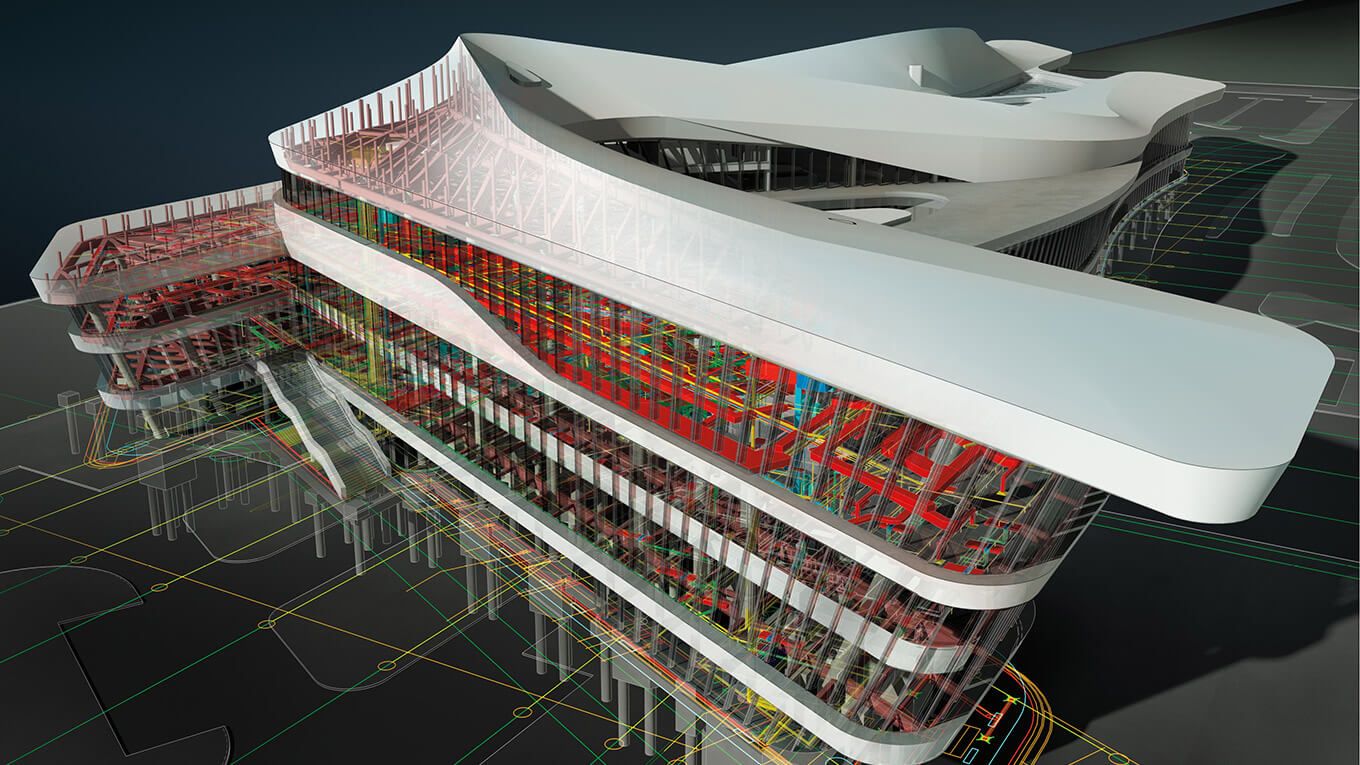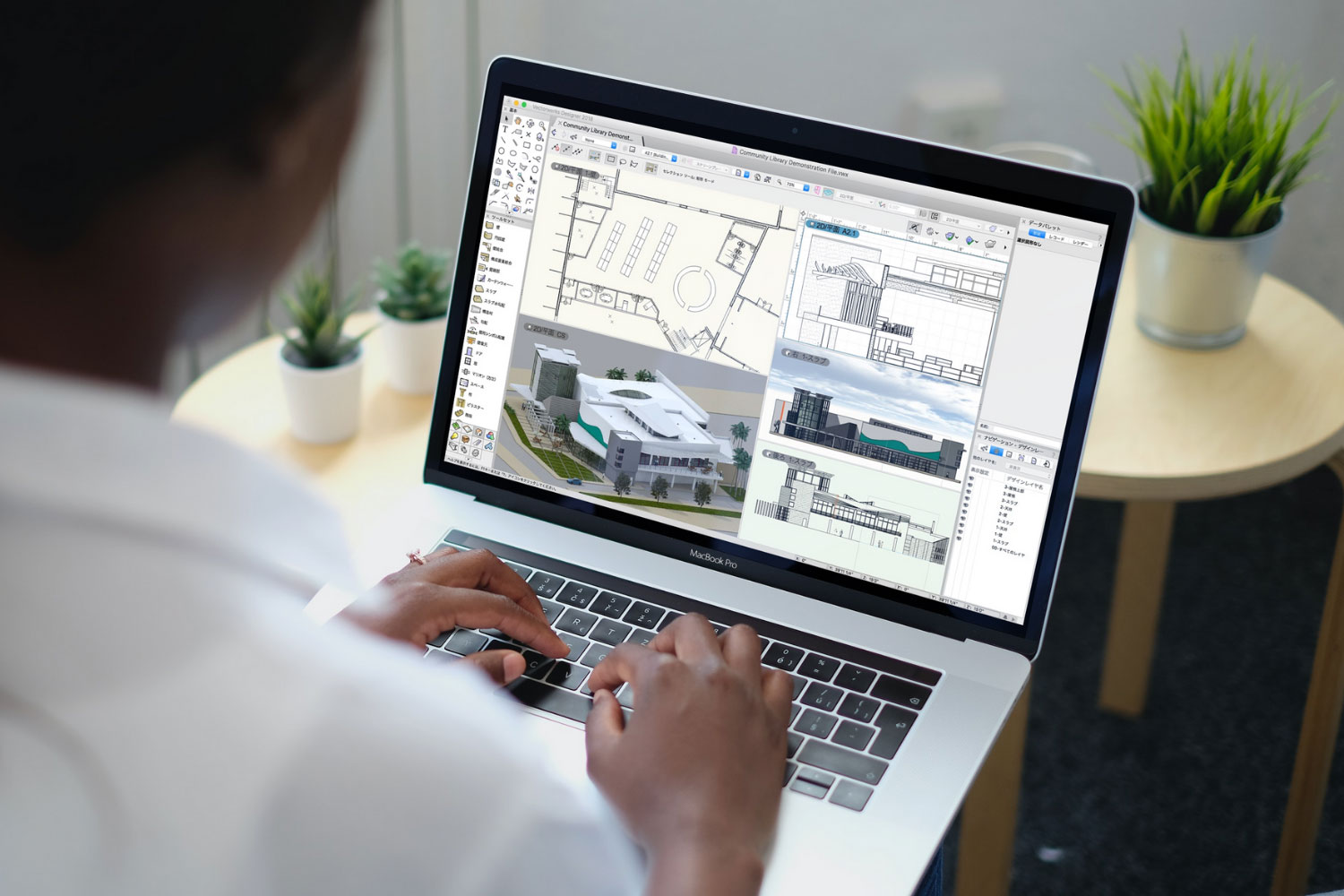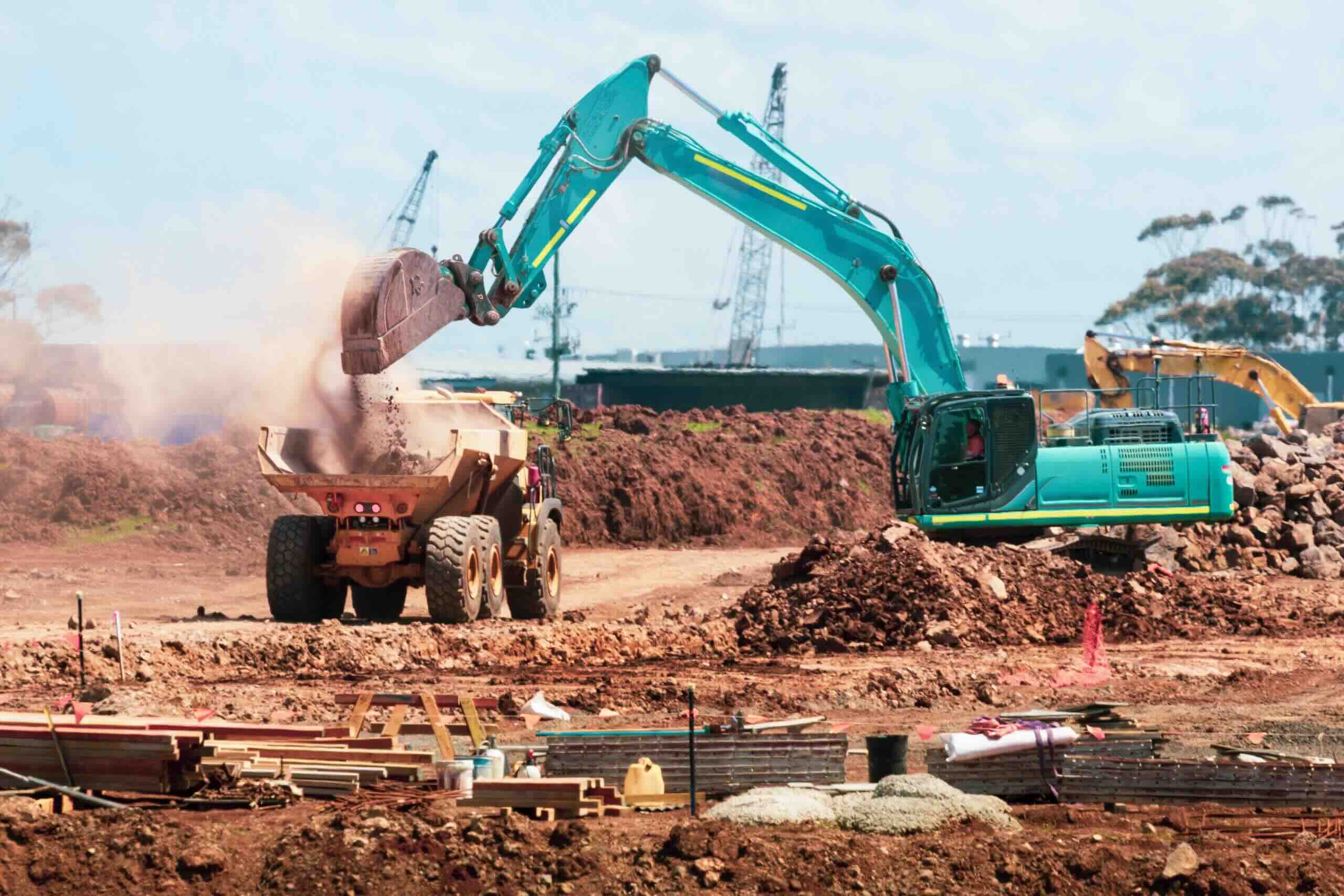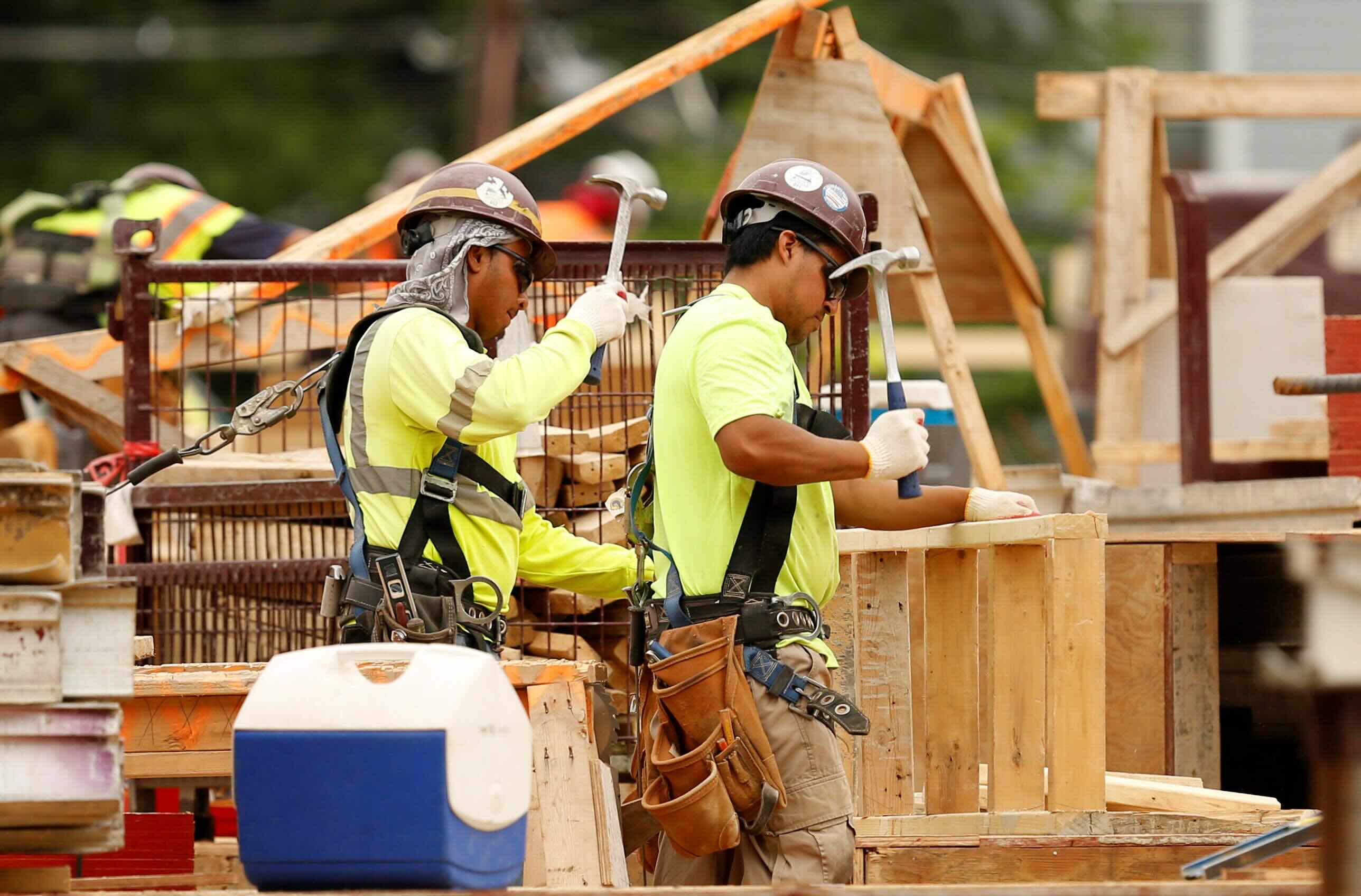Home>diy>Building & Construction>How Does BIM Impact The Construction Industry


Building & Construction
How Does BIM Impact The Construction Industry
Modified: January 24, 2024
Discover the transformative effects of Building Information Modeling (BIM) on the construction industry. Unleash the power of efficient planning, collaboration, and cost savings with BIM.
(Many of the links in this article redirect to a specific reviewed product. Your purchase of these products through affiliate links helps to generate commission for Storables.com, at no extra cost. Learn more)
Introduction
The construction industry is a complex and dynamic field that demands efficient collaboration, communication, and coordination among its various stakeholders. With advancements in technology, the industry has witnessed a significant shift towards digitally-driven solutions that streamline processes and improve overall project outcomes. One such technology that has revolutionized the construction landscape is Building Information Modeling (BIM).
BIM is a digital representation of the physical and functional characteristics of a building or infrastructure. It encompasses the entire lifecycle of a construction project, ranging from design and construction to operation and maintenance. BIM provides a holistic approach where all relevant information, such as geometry, quantities, and specifications, is integrated into a single 3D model.
The adoption of BIM has had a profound impact on the construction industry, offering a multitude of benefits for all stakeholders involved. This article will delve into the various benefits of BIM and analyze how it has transformed the construction industry.
Key Takeaways:
- Building Information Modeling (BIM) revolutionizes construction by enhancing collaboration, accuracy, and efficiency. It minimizes errors, reduces rework, and drives innovation, paving the way for a more sustainable built environment.
- The future of BIM holds promise with trends like cloud-based collaboration, IoT integration, VR/AR applications, and AI advancements. These developments will further optimize decision-making, building performance, and the construction process.
Read more: How Does Construction Impact The Environment
Definition and Explanation of BIM
Building Information Modeling (BIM) is a digital representation of the physical and functional characteristics of a building or infrastructure. It is a collaborative process that enables the creation and management of information during a construction project’s lifecycle. BIM goes beyond traditional two-dimensional (2D) drawings and encompasses a three-dimensional (3D) model that integrates data and information from various sources.
BIM allows architects, engineers, contractors, and other stakeholders to work together and share information in a coordinated and collaborative manner. The 3D model acts as a virtual representation of the building, providing a comprehensive view of the project scope, including the design, construction, operation, and maintenance aspects.
With BIM, every element of a building, from walls and floors to doors and windows, is represented as an object with defined properties and relationships. These objects can contain attributes such as dimensions, specifications, performance data, and manufacturer details. The interconnectedness of these objects enables stakeholders to make informed decisions and identify potential clashes or conflicts early in the design process.
In addition to the 3D model, BIM incorporates other dimensions, such as time and cost, to create a holistic understanding of the project. This allows for the simulation of construction sequencing, project schedules, and cost estimations. BIM can also be used for energy analysis, sustainability assessments, and facilities management, further enhancing its value throughout a building’s lifecycle.
Furthermore, BIM facilitates collaboration and communication among stakeholders by providing a common platform for sharing and accessing project information. This eliminates the need for multiple document versions and reduces the risk of miscommunication or errors. By working on the same platform, stakeholders can make simultaneous and coordinated updates, ensuring everyone is on the same page and working towards the same project goals.
Overall, BIM is a transformative technology in the construction industry. It fosters greater collaboration, improves project coordination, and enhances overall efficiency. With its ability to integrate data and information, BIM enables informed decision-making, reduces rework, and ultimately leads to better project outcomes.
BIM Benefits in the Construction Industry
The adoption of Building Information Modeling (BIM) has brought numerous benefits to the construction industry. From improved collaboration and communication to cost and time savings, BIM has revolutionized the way construction projects are planned, designed, and executed. Let’s explore some of the key benefits of BIM in more detail:
- Improved Collaboration and Communication: BIM serves as a central hub for all project stakeholders, allowing them to collaborate in real-time and exchange information seamlessly. This enhanced communication leads to better coordination, reduces conflicts and errors, and ensures that everyone involved is working towards the same project goals.
- Increased Accuracy and Efficiency: BIM enables accurate and precise modeling of building elements, resulting in higher quality designs and construction documentation. The use of intelligent objects ensures that all the necessary information is embedded within the model, reducing the risk of misunderstandings or omissions. This leads to improved construction efficiency and reduces rework.
- Cost and Time Savings: BIM facilitates better project planning and allows for more accurate cost estimations. With the integration of time schedules and construction sequencing, potential conflicts and delays can be identified early on, enabling timely adjustments. BIM also enables the identification of cost-saving opportunities by analyzing different design alternatives and construction methods.
- Enhanced Visualization and Simulation: BIM provides a realistic 3D visualization of the project, allowing stakeholders to better understand the design intent and identify potential design issues. It also allows for the simulation of different scenarios, such as construction sequencing, clash detection, and energy analysis. This enables proactive decision-making and reduces costly changes during construction.
- Reduction of Errors and Conflicts: Through the use of clash detection tools, BIM helps identify and resolve conflicts between different building systems, such as structural and mechanical. This prevents costly rework and ensures that all building components fit seamlessly together. By identifying clashes early in the design stage, project disruptions and delays can be minimized.
These benefits of BIM have transformed the construction industry, enabling better project outcomes, increased efficiency, and improved collaboration among project stakeholders. As BIM continues to evolve, its potential for further innovation and improvement will undoubtedly continue to shape the future of construction projects.
Improved Collaboration and Communication
One of the key benefits of Building Information Modeling (BIM) in the construction industry is its ability to significantly improve collaboration and communication among project stakeholders. In traditional construction projects, communication gaps and misunderstandings between architects, engineers, contractors, and other team members often lead to delays, conflicts, and costly rework. BIM addresses these challenges by providing a centralized platform for sharing and accessing project information, fostering greater collaboration throughout the entire construction process.
With BIM, all stakeholders can work on a single shared model, enabling real-time collaboration and exchange of information. This eliminates the need for multiple document versions and the risk of miscommunication caused by outdated or incomplete information. Every change made in the model is instantly visible to all team members, ensuring that everyone is working with the most up-to-date data.
BIM also breaks down traditional disciplinary boundaries by allowing different professionals to work together in a coordinated and interdisciplinary manner. For instance, architects can design in collaboration with structural engineers, electrical engineers, and mechanical engineers, ensuring that all aspects of the building are considered from the early stages of the project. This early collaboration helps identify and resolve potential conflicts or clashes between different building systems, reducing errors and rework during construction.
Through BIM, communication barriers between stakeholders are also minimized. By using a common language and a visual model, architects and engineers can better explain their design intent and communicate complex ideas to contractors and other team members. This improves understanding and reduces the chance of misinterpretation, ensuring that the project remains on track and meets the desired outcomes.
In addition, BIM provides tools for collaboration beyond the design stage. Contractors can use BIM models to plan construction sequencing and logistics, identifying potential issues and optimizing project timelines. Facility managers can also benefit from BIM by using the model to manage and maintain the building throughout its lifecycle.
Overall, improved collaboration and communication through BIM result in a more cohesive and efficient construction process. By fostering a collaborative environment, BIM enables project teams to work together seamlessly, share information effectively, and make informed decisions that contribute to better project outcomes. As technology continues to advance, BIM is expected to further enhance collaboration and revolutionize the way construction projects are executed.
Increased Accuracy and Efficiency
Building Information Modeling (BIM) has significantly impacted the accuracy and efficiency of construction projects. By utilizing BIM, the construction industry has transitioned from traditional two-dimensional (2D) drawings to three-dimensional (3D) models that incorporate rich data and information. This shift has brought numerous benefits, including improved accuracy in design and construction documentation and increased overall project efficiency.
With BIM, designers and engineers can create detailed 3D models that accurately represent the building’s components and systems. These models contain intelligent objects, such as walls, floors, doors, and windows, with embedded attributes and properties. As a result, every element in the model is defined, ensuring precise measurements, specifications, and performance information associated with each object.
The use of intelligent objects in BIM improves accuracy in design and construction documentation. Errors and omissions that often occur in traditional 2D drawings are minimized, as objects in the model are interconnected and interact with one another. For example, if a wall is moved or modified, the corresponding dimensions and relationships of other objects dynamically adjust to maintain accuracy throughout the model. This integrated nature of BIM reduces discrepancies that can lead to costly rework during construction.
In addition, BIM enhances coordination and clash detection between different building systems. By identifying clashes early in the design phase, conflicts between structural elements, mechanical systems, electrical installations, and other components can be detected and resolved before construction begins. This proactive approach minimizes errors and ensures that all building components fit seamlessly together, reducing conflicts and rework during construction.
BIM also improves construction efficiency by streamlining processes and enhancing communication between project teams. The detailed 3D model allows for better visualization of the project, helping contractors and subcontractors to accurately plan and execute construction activities. By simulating construction sequencing, material quantities, and cost estimates, BIM provides valuable insights that optimize project scheduling and resource allocation.
The use of BIM in quantity takeoff and cost estimation further improves project efficiency. The intelligent objects in the model contain embedded data on materials, quantities, and specifications. This information can be extracted to generate accurate quantity takeoffs and cost estimates, reducing the time-consuming manual processes traditionally associated with these tasks. Contractors can also simulate different design alternatives and construction methods in the BIM model, allowing for cost analysis and value engineering.
Overall, the increased accuracy and efficiency facilitated by BIM result in improved project outcomes, reduced rework, and enhanced productivity. By incorporating rich data and information into 3D models, BIM optimizes the design and construction process, saving time and cost while ensuring high-quality results. As technology and BIM tools continue to evolve, the accuracy and efficiency benefits are expected to further improve, revolutionizing the construction industry.
Read more: What Does BIM Stand For In Construction
Cost and Time Savings
Building Information Modeling (BIM) has proven to be a game-changer in terms of cost and time savings in the construction industry. By leveraging the power of digital technology and integrated data, BIM enables more accurate planning, better decision-making, and improved project management, resulting in significant cost and time efficiencies throughout the construction process.
One of the key ways that BIM facilitates cost savings is through better project planning and estimation. The detailed 3D model and embedded data within BIM enable more accurate quantity takeoff and cost estimation. Contractors can extract information from the model, such as material quantities and specifications, to generate precise and reliable estimates. This reduces the risk of underestimating or overestimating project costs, allowing for better budgeting and cost control.
Moreover, BIM enables the simulation of different design alternatives and construction methods, helping project teams identify cost-saving opportunities. By evaluating different options in the virtual environment, contractors can optimize construction sequencing, material usage, and resource allocation. This leads to more efficient and cost-effective construction processes, where unnecessary expenses can be eliminated or minimized.
BIM also contributes to time savings by enhancing project coordination and streamlining construction activities. With the 3D model as a central reference point, stakeholders can better visualize and understand the project scope, leading to improved decision-making and less time spent on conflicts and rework. Clash detection tools in BIM allow for early identification of clashes between different building systems, reducing the likelihood of delays and costly on-site modifications.
BIM’s integration of time schedules and construction sequencing further facilitates efficient project management. Using the 3D model, contractors can optimize construction sequences, plan for material deliveries, and identify potential scheduling conflicts. This enables better project coordination and reduces downtime, ultimately speeding up the construction process.
In addition, BIM’s ability to detect errors and conflicts early on helps prevent delays and rework. By identifying design clashes and constructability issues during the design phase, adjustments can be made before construction begins, avoiding costly on-site modifications and project disruptions. This not only saves time but also reduces the expenses associated with correcting errors and addressing conflicts during construction.
Furthermore, BIM’s visualization capabilities enable improved communication and collaboration, reducing delays caused by misunderstandings or miscommunication between project stakeholders. With everyone working from a shared digital model, information can be effectively communicated, and decisions can be made more efficiently. This eliminates the need for time-consuming back-and-forth communication and accelerates the decision-making process.
The cost and time savings achieved through the implementation of BIM have a significant impact on the overall success and profitability of construction projects. The ability to accurately estimate costs, optimize construction sequences, and minimize delays and rework results in improved project outcomes, increased productivity, and higher return on investment for all stakeholders involved.
Enhanced Visualization and Simulation
Building Information Modeling (BIM) has revolutionized the construction industry by providing enhanced visualization and simulation capabilities. With BIM, stakeholders can visualize a project in three-dimensional (3D) form, allowing for a more immersive and realistic understanding of the design and construction process.
One of the key benefits of enhanced visualization through BIM is the ability to better communicate design intent. Traditional two-dimensional (2D) drawings often struggle to convey the true spatial experience of a building. BIM, on the other hand, provides a 3D model that allows stakeholders to visualize and explore the design from various angles and perspectives. This enables architects, engineers, and clients to better understand the design, make informed decisions, and contribute to design improvements before construction begins.
BIM’s visualization capabilities also facilitate the identification of design issues and conflicts. By visualizing the project in 3D, stakeholders can identify potential clashes between different building systems, such as structural and mechanical elements. This allows for clash detection and resolution at an early stage, minimizing costly changes during construction. It also enhances constructability reviews, enabling stakeholders to assess the feasibility of the design and identify potential challenges or constraints.
Simulation is another powerful aspect of BIM. Stakeholders can simulate various aspects of the construction process, such as construction sequencing, material flows, and site logistics. This allows for better planning and optimization of construction activities, reducing inefficiencies and delays. For example, contractors can simulate the installation sequence of building components to identify potential clashes or coordination issues, ensuring a smoother construction process.
BIM also facilitates energy analysis and sustainability assessments. By incorporating energy-related data and simulations, stakeholders can evaluate the environmental impact of a building’s design. This allows for better decision-making regarding energy efficiency strategies, material choices, and the integration of renewable energy sources. BIM’s simulation capabilities provide valuable insights into the potential energy performance of a building, helping to optimize its sustainability credentials.
In addition to design and construction, BIM’s visualization and simulation capabilities extend to facility management. The 3D model can be used as a platform to manage building operations, maintenance, and renovations. Facility managers can access the model to quickly locate building components, access relevant documentation, and plan facility upgrades or repairs. This streamlines facility management processes and enhances the overall facility lifecycle.
Overall, enhanced visualization and simulation through BIM empower stakeholders with a better understanding of the project, improved design coordination, and the ability to make informed decisions. By visualizing designs and simulating construction processes, BIM enhances project efficiency, reduces errors and conflicts, and contributes to improved project outcomes. The visualization and simulation capabilities of BIM continue to evolve, allowing for even more advanced and realistic representations of construction projects in the future.
Reduction of Errors and Conflicts
Building Information Modeling (BIM) has had a significant impact on the construction industry by reducing errors and conflicts throughout the entire project lifecycle. BIM’s integrated approach and collaboration capabilities enable stakeholders to identify and resolve issues before construction begins, resulting in smoother and more efficient projects.
One of the primary ways that BIM reduces errors is through clash detection. Clash detection tools identify potential clashes or conflicts between different building systems, such as structural elements and mechanical systems, within the 3D model. By detecting clashes early in the design phase, clashes that could lead to costly rework or construction delays are minimized. This proactive approach allows stakeholders to make necessary adjustments and modifications to the design before construction commences.
In addition to clash detection, BIM reduces errors by ensuring coordinated and accurate documentation. All relevant project data, such as dimensions, specifications, and performance parameters, are embedded within the 3D model. This eliminates the need for manually updating and coordinating multiple sets of drawings or documents, reducing the chance of errors caused by outdated or inconsistent information. By working from a single source of truth, stakeholders can trust that the information they are using is up-to-date and accurate.
BIM also facilitates improved coordination and communication between project stakeholders, which further reduces errors and conflicts. With everyone working from the same 3D model, misunderstandings and miscommunications caused by disparate sets of information are minimized. Changes made to the model are instantly visible to all stakeholders, ensuring that everyone has the most current information at their disposal. This streamlined communication and collaboration approach leads to a reduction in errors caused by misinterpretations or incomplete information.
Moreover, BIM provides better visualization and understanding of the project, enabling stakeholders to detect and address potential issues before they become major problems. The realistic 3D model allows for a comprehensive view of the design, making it easier to identify design conflicts, visual discrepancies, or structural issues that could impact the construction process. By having a more accurate representation of the project, stakeholders can proactively address these issues and avoid costly errors during construction.
By reducing errors and conflicts, BIM contributes to improved project quality and efficiency. Early detection and resolution of clashes and design issues minimize the need for rework, resulting in cost and time savings. Construction processes can be executed more smoothly, and project schedules can be adhered to with greater precision. Ultimately, the reduction of errors and conflicts through BIM leads to projects being completed more successfully, within budget, and to the satisfaction of all project stakeholders.
Utilize BIM to improve collaboration and communication among project stakeholders, leading to better coordination, reduced errors, and improved efficiency in the construction process.
BIM Challenges in the Construction Industry
While Building Information Modeling (BIM) offers numerous benefits and has transformed the construction industry, it also presents several challenges that need to be addressed for its successful implementation. These challenges range from initial investment and training to data management and legal considerations. Understanding and addressing these challenges is crucial for the effective adoption and utilization of BIM in construction projects.
- Initial Investment and Training: Implementing BIM requires a significant initial investment in software, hardware, and training. The cost of acquiring and licensing BIM software, as well as the hardware infrastructure to support it, can be a barrier for smaller firms or organizations with limited budgets. Additionally, proper training is necessary for all project stakeholders to effectively utilize BIM tools and workflows.
- Integration and Implementation Issues: Integrating BIM into existing systems and workflows can be challenging. Organizations need to align their processes and workflows with BIM standards and guidelines. Implementing BIM across different disciplines and ensuring smooth collaboration among stakeholders may require a cultural shift within the organization and a reevaluation of traditional approaches to project delivery.
- Data Management and Standardization: BIM generates a vast amount of data throughout the project lifecycle. Managing and organizing this data effectively is critical for BIM’s success. Developing and implementing data management strategies, including naming conventions, file structures, and classification systems, is necessary to ensure consistency and efficient data sharing. Standardization of data formats and interoperability among different BIM software platforms is also a challenge that needs to be addressed.
- Legal and Contractual Considerations: BIM introduces new legal and contractual challenges. Ownership and sharing of BIM models, intellectual property rights, liability, and contractual responsibilities are some of the legal issues that need to be addressed. Clear contractual agreements and legal frameworks should be established to define the rights, responsibilities, and liabilities of each party involved in a BIM project.
- Collaboration and Information Sharing: BIM heavily relies on collaboration and information sharing among stakeholders. However, maintaining effective communication and collaboration across different disciplines and parties can be challenging. Data and information exchange protocols and ensuring secure access to the BIM model need to be established to protect sensitive project information while allowing for effective collaboration.
Despite these challenges, it is important to acknowledge that the benefits of BIM outweigh the associated difficulties. Many of these challenges can be overcome through proper planning, training, and the development of standardized processes and guidelines. By addressing these challenges, the construction industry can leverage the full potential of BIM and enhance project outcomes, collaboration, and efficiency.
Initial Investment and Training
One of the primary challenges in implementing Building Information Modeling (BIM) in the construction industry is the initial investment required and the associated training costs. While BIM offers significant benefits, such as improved collaboration and increased efficiency, the upfront investment can be a barrier for some companies, particularly smaller firms or organizations with limited budgets.
To fully embrace BIM, organizations need to invest in the necessary software, hardware, and infrastructure to support its implementation. This includes acquiring licenses for BIM software, such as Autodesk Revit or ArchiCAD, which can entail substantial costs. Additionally, the hardware infrastructure must be capable of handling the processing power required to work with complex 3D models and datasets.
Alongside the financial investment, training plays a crucial role in the successful adoption of BIM. As BIM workflows and processes differ significantly from traditional methods, all project stakeholders need to be adequately trained to effectively use the software and understand the collaborative nature of BIM. Training programs can range from general BIM concepts to specialized training in specific software applications.
Training can be costly and time-consuming, requiring resources for trainers, materials, and the time commitment of staff. However, investing in proper training is essential to ensure the successful implementation and utilization of BIM within the organization. Without adequate training, the full potential of BIM may not be realized, and the benefits it offers may not be fully harnessed.
There are several approaches to training in BIM. In-house training programs conducted by experienced BIM professionals can be effective in providing tailored knowledge and support. Companies can also opt for external training courses or workshops offered by BIM training providers or industry associations.
Fortunately, as BIM continues to gain traction in the construction industry, the availability of training resources is increasing. Online tutorials, webinars, and self-paced learning modules are becoming more common and can supplement formal training programs.
Organizations should also focus on establishing a culture of continuous learning and development. Encouraging employees to participate in conferences, seminars, and industry events related to BIM can help expand their knowledge and keep them up to date with the latest advancements in the field.
While the initial investment and training costs associated with BIM implementation can be significant, it’s important to view them as long-term investments that yield substantial benefits. The improved collaboration, efficiency, and productivity offered by BIM can outweigh the initial costs, leading to enhanced project outcomes and a competitive edge in the industry.
Integration and Implementation Issues
Implementing Building Information Modeling (BIM) in the construction industry presents several integration and implementation challenges. While BIM offers numerous benefits, integrating it into existing systems, workflows, and project delivery methods requires careful planning and consideration. The following are key integration and implementation issues that organizations may face when adopting BIM.
Alignment with Existing Systems and Workflows: BIM implementation requires organizations to align their existing systems and workflows with BIM processes. This can be challenging, especially for companies with well-established practices that may need to be modified or replaced. Integrating BIM into existing systems without disrupting ongoing projects or compromising project timelines requires thoughtful planning and phased implementation.
Cultural Shift and Stakeholder Buy-In: Implementing BIM successfully often requires a cultural shift within the organization. Traditional work cultures and established practices may resist change. Encouraging stakeholder buy-in and fostering a collaborative environment are crucial for the successful implementation of BIM. Open communication, providing training and support, and highlighting the benefits of BIM can help overcome resistance and facilitate adoption.
Standardization and Interoperability: Standardization and interoperability are significant challenges when implementing BIM across different disciplines and stakeholders. Developing and adopting consistent naming conventions, file structures, and classification systems ensure that data is structured in a consistent and meaningful manner. Interoperability between various BIM software platforms is also crucial to ensure seamless data exchange and collaboration between project participants.
Quality Assurance and Quality Control: Implementing BIM requires a robust quality assurance and quality control process. Checking the consistency, accuracy, and completeness of the BIM model and associated data is essential to avoid errors and conflicts. Establishing internal quality control procedures and implementing regular audits can help identify and rectify any issues during the BIM implementation process.
Training and Skill Development: Proper training is vital for the successful implementation and utilization of BIM. Staff at all levels need to be trained not only in the use of BIM software but also in understanding BIM principles, workflows, and best practices. Providing ongoing training opportunities and encouraging skill development will ensure that the organization maximizes the potential of BIM technology.
Collaboration and Information Exchange: Effective collaboration and information exchange among stakeholders are critical for BIM implementation. Establishing clear protocols for communication and sharing of information, including version control and access permissions, helps to avoid misunderstandings and conflicting data. Encouraging regular project team meetings and utilizing collaboration platforms enable seamless communication and collaboration throughout the project lifecycle.
Overcoming these integration and implementation challenges requires a well-thought-out strategy and commitment from the organization. Engaging experienced BIM consultants or experts who can guide the integration process can be beneficial. By addressing these challenges, organizations can fully harness the potential of BIM to enhance project outcomes and achieve the desired benefits of improved collaboration, coordination, and efficiency within the construction industry.
Data Management and Standardization
One of the key challenges in implementing Building Information Modeling (BIM) in the construction industry is effective data management and standardization. BIM generates and encapsulates a vast amount of data throughout the project lifecycle, and managing this data efficiently is crucial for successful BIM implementation. Here are some key considerations for data management and standardization in BIM:
Data Structure and Organization: Developing a well-defined and consistent data structure is essential for effective BIM implementation. The data should be organized in a logical hierarchy, ensuring that it is easily searchable and accessible to project stakeholders. This includes establishing naming conventions, file structures, and classification systems that facilitate efficient data management and retrieval.
Data Quality Assurance: Ensuring the quality and accuracy of data is vital for reliable BIM implementation. Regular quality checks and audits should be conducted to identify and rectify any errors or inconsistencies in the BIM models. Implementing quality control procedures and establishing data validation protocols can help maintain the integrity and reliability of the data.
Version Control and Change Management: BIM models undergo continuous changes and updates throughout the project lifecycle. Implementing proper version control mechanisms ensures that all stakeholders are working with the most up-to-date information. By documenting changes, tracking revisions, and managing conflicts, effective change management can be achieved, minimizing the risk of errors and conflicts caused by outdated or conflicting data.
Data Interoperability and Integration: BIM often involves collaboration among multiple stakeholders who use different software platforms and systems. Ensuring interoperability and seamless data exchange between different software applications is crucial for effective collaboration and information sharing. Establishing open standards and adopting industry-recognized file formats, such as IFC (Industry Foundation Classes), promotes interoperability and enables data integration across various BIM platforms.
Data Security and Confidentiality: BIM data can be sensitive and confidential, especially during the pre-construction and design phases. Implementing appropriate data security measures, including access controls, encryption, and secure data storage, is essential to protect sensitive project information. Establishing data sharing protocols, defining roles and responsibilities, and ensuring compliance with data protection regulations can help safeguard project data.
Training and Skill Development: Effective data management in BIM requires trained professionals who understand data management principles and best practices. Providing training and skill development opportunities to staff members involved in BIM implementation ensures that they have the necessary knowledge and skills to handle data effectively. This includes training on BIM software, data management strategies, and industry standards.
Industry Standards and Guidelines: Embracing industry standards and guidelines plays a crucial role in data management and standardization. Industry organizations and associations, such as buildingSMART and National BIM Standards, have developed best practices and guidelines for BIM data management. Implementing these standards helps ensure consistency, interoperability, and effective collaboration among project stakeholders.
By addressing data management and standardization challenges, organizations can optimize the benefits of BIM. Effective data management enables stakeholders to access accurate and reliable information, streamline decision-making processes, enhance collaboration, and improve overall project outcomes. It provides a strong foundation for successful BIM implementation and ensures the long-term value and usability of BIM data throughout the project lifecycle.
Legal and Contractual Considerations
The implementation of Building Information Modeling (BIM) in the construction industry brings forth a range of legal and contractual considerations. As BIM introduces new ways of working and sharing information, it is essential to address the legal implications and ensure that appropriate contractual frameworks are in place to protect the rights and interests of all parties involved. Here are some key legal and contractual considerations for BIM implementation:
Ownership and Sharing of BIM Models: Determining ownership and control of the BIM models and the associated intellectual property rights is crucial. It is necessary to clearly define the rights and responsibilities of each party involved in the project, including the ownership of the BIM model and the extent to which it can be shared or used beyond the project’s scope. This can be addressed through contracts, including provisions that outline the ownership and usage rights of the BIM models.
Liability and Responsibility: BIM introduces new avenues for potential liabilities and responsibilities. Determining who is responsible for the accuracy of the information within the BIM model and who bears the liability for any errors or omissions is important. Contracts and legal agreements should clearly outline the respective responsibilities of the project participants and define the extent of liability for any issues arising from the use of BIM models.
Contractual Agreements: Contracts need to be revised and updated to incorporate BIM-related specifications and requirements. Establishing clear contractual agreements that explicitly define the use of BIM, the sharing of data, and the collaboration between project stakeholders is essential. These agreements should outline the BIM requirements, including the desired level of detail (LOD), the information exchange protocols, and the expectations regarding the use and access to the BIM models.
Data Protection and Confidentiality: BIM implementations involve the exchange of sensitive project information among multiple stakeholders. Ensuring data protection and confidentiality is critical. Legal agreements should include provisions for data protection, confidentiality, and security measures regarding the sharing and storage of BIM data. It is important to establish protocols for data sharing, access controls, and data encryption to safeguard confidential project information.
Standard of Care and Professional Liability: The adoption of BIM may impact the standard of care required from professionals involved in the project. Designers, engineers, and other professionals implementing BIM need to understand and meet the appropriate standard of care in producing and managing BIM models. Legal agreements and contracts should reflect the changes in professional responsibilities and liability standards arising from the integration of BIM into project workflows.
Dispute Resolution: Establishing mechanisms for dispute resolution in BIM projects is important to address any conflicts that may arise during the implementation or use of BIM. Contracts can include provisions for alternative dispute resolution methods, such as mediation or arbitration, to resolve conflicts efficiently and effectively. These provisions should address the unique challenges and considerations associated with BIM.
To navigate the legal and contractual challenges posed by BIM, it is advisable to seek legal counsel to ensure that the contracts and legal agreements adequately address the specific requirements and issues associated with BIM implementation. Moreover, staying up-to-date on industry standards and guidelines can also provide valuable insights into addressing legal and contractual considerations related to BIM implementation.
By addressing these legal and contractual considerations, stakeholders can protect their interests, define their rights and responsibilities, and establish a framework that supports the successful implementation and use of BIM in construction projects.
Read more: What Is The Construction Industry
Future Trends and Developments in BIM
Building Information Modeling (BIM) is a rapidly advancing technology in the construction industry, and there are several exciting future trends and developments on the horizon. As technology continues to evolve, BIM is expected to enhance its capabilities and shape the construction industry. Here are some key trends to watch out for in the future of BIM:
Cloud-Based Collaboration: The use of cloud-based platforms for BIM collaboration is likely to become more prevalent in the future. Cloud-based solutions offer seamless collaboration and information sharing among project stakeholders, irrespective of their physical location. This will further enhance the efficiency and accessibility of BIM, enabling real-time collaboration and streamlined project coordination across different teams and disciplines.
Internet of Things (IoT) Integration: BIM can leverage the power of IoT by integrating with various sensor technologies and devices present in the built environment. This integration will allow for real-time data collection and analysis, enabling proactive decision-making and predictive maintenance. By connecting BIM models with sensors, systems within buildings can be monitored, optimizing energy use, and improving overall operational efficiency.
Virtual and Augmented Reality (VR/AR) Applications: VR and AR technologies are becoming increasingly sophisticated and accessible. BIM models can be visualized through immersive virtual and augmented reality experiences, providing stakeholders with a better understanding of the design intent and construction processes. This visualization will enable better communication, enhanced stakeholder engagement, and more effective design reviews, thereby improving project outcomes.
Artificial Intelligence (AI) and Machine Learning: The integration of AI and machine learning algorithms will further enhance BIM’s capabilities. AI can automate routine tasks, such as clash detection and quantity takeoff, saving time and reducing errors. Machine learning can enable BIM systems to learn from previous projects, optimizing design decisions, predicting construction schedules, and identifying potential issues before they occur.
Generative Design: Generative design involves using algorithms to explore a vast range of design options based on specific parameters and constraints. By incorporating generative design within BIM workflows, architects and designers can quickly create and evaluate multiple design alternatives, maximizing efficiency, and exploring innovative solutions. This will enable design optimization, resource efficiency, and improved building performance.
Integration with Facility Management: BIM’s integration with facility management systems will further enhance the lifecycle management of buildings. BIM models can serve as a foundation for facility management activities, enabling better asset management, operation, and maintenance. Real-time data from building systems and IoT devices can be integrated with BIM, facilitating predictive maintenance and improving overall facility performance.
Data Analytics and Predictive Insights: BIM’s ability to capture a vast amount of data will fuel advancements in data analytics and predictive insights. By leveraging advanced analytics tools, BIM models can provide predictive insights on energy performance, occupant comfort, and maintenance needs. This will enable proactive decision-making, optimizing building performance throughout its lifecycle.
In summary, the future of BIM holds great promise for the construction industry. Cloud-based collaboration, IoT integration, VR/AR applications, AI and machine learning, generative design, facility management integration, data analytics, and predictive insights are just a few of the exciting trends that will shape the future of BIM. These advancements will revolutionize the construction process, drive efficiency, and result in more sustainable and intelligent built environments. It is essential for construction professionals to stay informed and adapt to these upcoming trends to leverage the full potential of BIM in their projects.
Conclusion
Building Information Modeling (BIM) has transformed the construction industry by revolutionizing the way projects are planned, designed, and executed. The benefits of BIM are immense, ranging from improved collaboration and communication to increased accuracy and efficiency. BIM enables stakeholders to work together seamlessly, share information effectively, and make informed decisions, resulting in better project outcomes.
Through enhanced collaboration and communication, BIM brings all project stakeholders onto a common platform, enabling real-time collaboration and exchange of information. This eliminates miscommunication and ensures that everyone involved is working towards the same project goals. The 3D visualization provided by BIM improves understanding and decision-making, leading to better design coordination and clash detection during the early stages of a project.
By increasing accuracy and efficiency, BIM minimizes errors and reduces rework, thus saving time and cost. The detailed 3D models, coupled with intelligent objects, ensure precise measurements and specifications, reducing misunderstandings and omissions. BIM’s simulation capabilities allow for optimization of construction sequences, cost estimations, and energy analysis, leading to more efficient project planning and execution.
BIM also addresses the challenges faced by the construction industry, such as conflicts, delays, and coordination issues. The clash detection tools in BIM identify clashes between different building systems, enabling early resolution and avoiding costly changes during construction. With reduced errors and conflicts, projects can be completed with higher quality, within budget, and on schedule.
However, BIM implementation comes with its own set of challenges. These challenges include the initial investment and training required, integration with existing systems and workflows, data management and standardization, and legal and contractual considerations. Organizations need to address these challenges to fully leverage the benefits of BIM and ensure successful implementation.
Looking towards the future, BIM continues to evolve with cloud-based collaboration, integration with IoT and AI technologies, VR/AR applications, generative design, and advanced data analytics. These trends will further enhance BIM’s capabilities, enabling stakeholders to make more informed decisions, optimize building performance, and transform the construction process.
In conclusion, BIM is a game-changer for the construction industry. By improving collaboration, increasing accuracy and efficiency, reducing errors and conflicts, and driving innovation, BIM has become an indispensable tool in the construction process. Embracing BIM and addressing the challenges it presents will pave the way for a more sustainable, efficient, and intelligent built environment.
Frequently Asked Questions about How Does BIM Impact The Construction Industry
Was this page helpful?
At Storables.com, we guarantee accurate and reliable information. Our content, validated by Expert Board Contributors, is crafted following stringent Editorial Policies. We're committed to providing you with well-researched, expert-backed insights for all your informational needs.













0 thoughts on “How Does BIM Impact The Construction Industry”